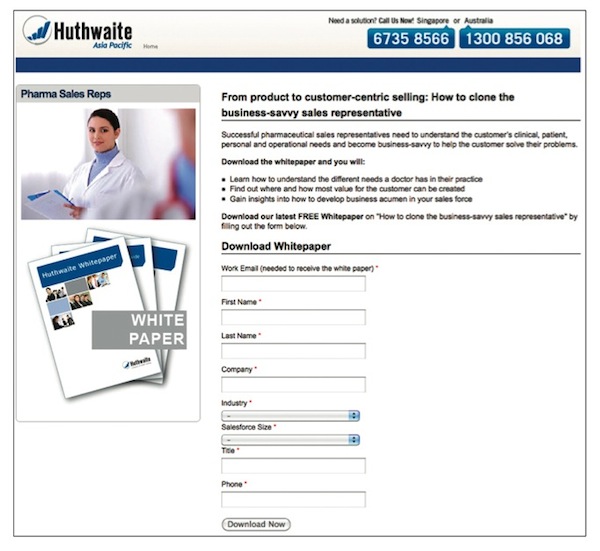Blogging for the pharmaceutical sector
Share
Client: Huthwaite Asia Pacific
Background
Huthwaite Asia Pacific’s business is sales performance improvement.
A pioneer in the application of behavioural analysis to benchmark sales excellence in the field, the company combines empirical research with world-class training to improve the effectiveness of professional sellers. Simply stated, it makes salespeople better.
But, while the company boasts a strong client base in industries such as banking and finance, information technology and manufacturing, its numbers in the lucrative medical and pharmaceutical sectors were far less impressive.
One year ago, Huthwaite was generating zero medical and pharmaceutical leads. Not only were the company’s existing databases for these industries small, they were also outdated. Huthwaite needed new contacts, so that it could start to build a profile and market its products to these sectors.
In order to establish itself as the thought leader in sales performance for the medical and pharmaceutical industries, Huthwaite had to drastically increase the amount of tailored content it had for this vertical.
So the company hired Izzy Wakeling.

Formerly the general manager for Asia at eyeforpharma, a company specialising in conferences for senior sales and marketing executives in the pharmaceutical industry, Wakeling brought a wealth of industry knowledge and experience to Huthwaite.
A big part of Wakeling’s previous role was to position eyeforpharma as a thought leader in the pharmaceutical industry in Asia. She achieved this through conferences, blogs, articles, seminars and reports on ‘buzz’ topics such as emarketing, patient compliance and a new commercial model
in pharmaceuticals. This experience, particularly the use of blogging as a marketing tool, would prove invaluable in her work on the Huthwaite campaign.
Objective
Huthwaite recognised that quality content production was the key to generating medical and pharmaceutical leads and reaching sales managers, marketing executives and general managers in these industries.
Wakeling was tasked with applying her knowledge of the medical and pharmaceutical industries to produce a wide range of tailored content, including a high-quality blog focusing on key issues affecting the industries. Huthwaite also sought to establish itself as a thought leader in sales performance for the sectors.
The challenges facing Wakeling were numerous. As mentioned, Huthwaite’s lead generation for the medical and pharmaceutical industries was nonexistent and its databases small and outdated. Wakeling and Huthwaite’s marketing team had to build new contacts and databases from scratch.
She also had to find time to write the blog and other content while prospecting and bringing in sales for the company.
“Coming up with new ideas for blogs wasn’t always easy. It required keeping your mind open and spotting trends and ‘hot’ topics when talking to and consulting with clients,” says Wakeling.
Strategy
While Huthwaite has a successful track record of producing authoritative whitepapers and surveys on sales performance, blogging was identified as an easier format to produce content quickly and increase website traffic and downloads from the untapped medical and pharmaceutical industries.
The fluid, informal style of a blog could be anything from 30 to 300 words in length. Blogging also helps build up a base of content that is indexed by search engines.
“It’s a bit like being a popular author in a book store,” says Wakeling. “The more books you have on the shelves, the more chance someone is going to stumble over something you have written and pick it up. If your content is engaging enough, the reader will hopefully buy your book or, in our case, download one of our whitepapers or register for our mailing list.
“Once you capture your readers on your email list or social media platform, you can then push further engaging content to them,” she adds.
Producing more detailed content was also part of the medical and pharmaceutical campaign. Wakeling rewrote several existing Huthwaite whitepapers to be medical and pharmaceutical industry specific.
Huthwaite also started a LinkedIn group for those in the medical and pharmaceutical sectors and sought to actively spread its content onto other LinkedIn and social media groups.
The marketing team also produced an industry specific survey to poll sales staff in the medical and pharmaceutical sectors, with the aim of generating content and statistics for publicity and future articles.
Execution
Wakeling wrote more than 30 blog articles, delving into topics ranging from the difficulties of pharmaceutical product launches to increasing face time with doctors. These topics were often drawn from conversations with clients in the industry.
“It wasn’t uncommon for one client to discuss the same challenge as another client and I used these common threads to help me to ignite an idea for a blog,” explains Wakeling.
“We also made sure that whatever blog topic was being chosen was in line with our marketing strategy and how Huthwaite wanted to be positioned in the sector.”
To generate traffic to the blog, the content was optimised for Google and focused on longer keywords to ensure rankings.
Wakeling also turned to LinkedIn to spread the blog content, utilising her own profile and various medical and pharmaceutical-focused groups. She made a habit of posting comments that were controversial or posed questions to the reader to generate intrigue and make them click through to the blog.
The blog posts themselves generally included a call to action encouraging readers to click through and download one of Huthwaite’s whitepapers.

Wakeling rewrote nine whitepapers to include a focus on the medical and pharmaceutical sectors. Gated content, these whitepapers require user registration before they can be accessed and are thus a key tool for Huthwaite to build new contacts and databases.
Huthwaite’s blog also directed readers to the company’s first pharmaceutical-focused survey. Posing questions about sales targets, forecasts and challenges to sales and marketing staff in the pharmaceutical industry, the survey was another important resource for obtaining new contacts.
Once in the Huthwaite database, contacts were nurtured with an email campaign providing more content and encouragement to return to the Huthwaite website, re-engage with the company and consider its products.
Results
In less than a year, Huthwaite went from generating zero medical and pharmaceutical leads to nearly 1000 leads. And this growth shows no sign of slowing.
Wakeling’s blog articles have produced a 34% average conversion rate (visit to lead) and are helping to establish Huthwaite as a thought leader in sales training for the medical and pharmaceutical industries.
One of her articles, titled ‘What is the pharmaceutical sales force for?’, even climbed into Huthwaite’s top 10 viewed posts with more than 600 views in a three-month period. The article (http:// blog.huthwaite.com.au/bid/56123/ What-is-the-pharmaceutical-salesforce-for) is a prime example of why the blog was such a success, showcasing Wakeling’s less formal, chatty style and fondness for drawing on her own personal experiences. Thanks to the blog, Huthwaite is also now generating traffic and leads for 73 medical and pharmaceutical related keywords.
The nine pharmaceutical-focused whitepapers have produced more than 970 leads to date, while the LinkedIn group has grown from 0 to 154 members and counting.
Wakeling attributes the campaign’s success to the quality and consistency of the content produced. “We made sure we had something new up on the blog every month and the quality of content was strong and relevant to our potential customers,” she says. “The aim is that this content will continue to generate leads for Huthwaite for years to come.”
cmw13















